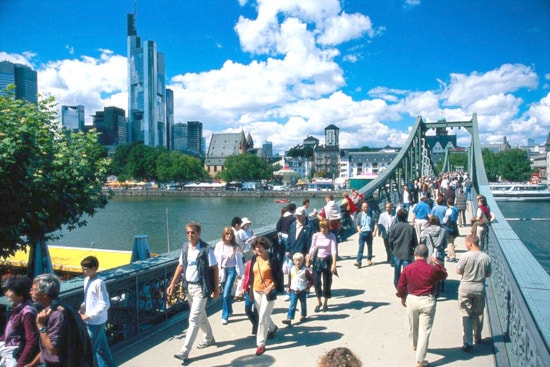Every year, Germany’s biggest and most popular cities attract millions of visitors from all over the world. Everyone from business travellers and cultural aficionados to shopaholics and party animals will find exactly what they’re looking for.
Frankfurt’s people are proud of their city, which puts most others in the shade when it comes to quality of life. There are rivers in other cities, of course, but few are as dominant as in Frankfurt.
The bridges spanning the Main are attractions in themselves, each one different in architecture and character. And choosing on which of the two footbridges to cross the river is almost a question of attitude. Are you more traditional, serene and sturdy like the neo-Gothic Eiserner Steg from 1869, or flamboyant, colourful and unconventional like the steel Holbeinsteg built in 1990?
A captivating urban landscape lies either side of the river, with towering skyscrapers, beautiful old mercantile houses, pretty churches and elegant museums.
Frankfurt has such a diversity of periods and styles that it could almost serve as an open-air museum. But it also reads like a who’s who of modern architecture. Oskar Mathias Ungers, Hans Hollein, Richard Meier, Helmut Jahn, Herzog & de Meuron and many others have made Frankfurt perhaps the most modern-looking city in Germany.
The poet Goethe remains a presence in modern-day Frankfurt, and anyone going in search of his history will also happen upon many of the city’s main sights.
Starting in central Frankfurt at the house where he was born, the route proceeds into Goethestrasse, one of the city’s most exclusive shopping streets.
It’s then onto Hauptwache square at the very heart of Frankfurt and across the Main to the Städel Institute of Art to see Hans Tischbein’s famous portrait ‘Goethe in the Roman Campagna’. Not much further south lies the Stadtwald forest, where an ascent of the 45-metre high wooden Goethe Tower is rewarded with fabulous views across the entire city.
The route back to the centre could take in one of Frankfurt’s oldest restaurants, the Gerbermühle, which is idyllically located on the banks of the Main.
As a friend of the then leaseholder, banker Johan Jakob von Willemer, Goethe was a regular patron. He fell madly in love with Willemer’s foster daughter Marianne at the tavern and could often be seen there enjoying a glass or two or apfelwein.
To this day, this traditional cider remains the most popular drink among the locals.
The Gerbermühle was also a likely haunt of the Frankfurt doctor Heinrich Hoffmann, whose illustrated Struwwelpeter books became classics of children’s literature.
In an old villa in the upmarket Westend district there is a museum devoted to Hoffman and the Struwwelpeter character, featuring drawings, rare editions, translations, parodies and much more besides. Another Frankfurt repository of illustrated stories is the Caricatura, Germany’s leading museum for refined satire and comic art. These are just two of nearly 60 museums in Frankfurt, and both the Struwwelpeter and the Caricatura are entirely unique to the city.
Away from big business, architecture, culture and cider, Frankfurt has a whole other side to discover.
The GrünGürtel, a belt of green land around the city, offers 80 square kilometres of natural scenery for people to stretch their legs in the fresh air. Recognized by the United Nations as a prime example of sustainable urban development, it encompasses forests, parks, meadows, farmland, rivers and lakes, and features a rich diversity of plant and animal life.
The green belt’s emblem is a friendly character called the Grüngürteltier, who has so far only been spotted in Frankfurt’s leafy surroundings.
If you want to experience sightseeing at its best in Frankfurt, hop on the Ebbelwei Express, a colourful historical tram. With plenty of music, pretzels and local cider, the party soon gets into full swing.
Here in Sachsenhausen, with its friendly atmosphere, narrow cobbled streets and more than 100 traditional bars serving locally produced cider, you’ll quickly make new friends.
The people of Frankfurt love nothing more than to sit or stand side by side with visitors in the quaint bars and traditional inns of Sachsenhausen’s old quarter and put the world to rights.
For more information on tourism in Germany or what there is to do in Frankfurt visit www.germany.travel/en
